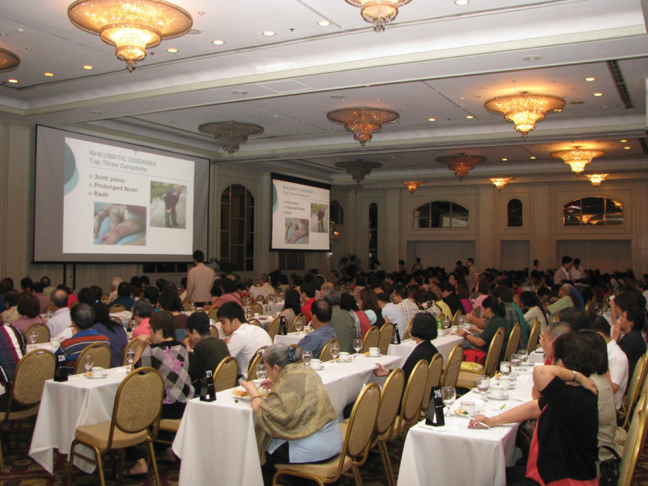Dermatologic Disorders
Daisy King Ismael, M.D.
Dermatologic diseases require consultation with a specialist. Some of these conditions include the following.
Urticaria, which is an allergic reaction characterized by generalized itchy wheals and may be caused by food, drugs, food additives, infections, and others. These are sometimes accompanied by angioedema (swelling of the eyes) and laryngeal edema, which may cause difficulty in breathing if not treated early.
Erythema Multiforme is an allergic reaction characterized by generalized itchy papules. Causes are similar to urticaria and effects can progress to more sever Stevens Johnson Syndrome. It is characterized by generalized sloughing of the skin and patients can die of sepsis, electrolyte imbalance and renal failure if not treated promptly.
Contact Dermatitis is a common skin disease caused by allergens like nickel, rubber, hair dye, cement and irritants like detergents and other cleansers. Lesions may spread to other parts of the body, become infected and thick and characterized by chronic scratching.
Bacterial Infections also cause skin conditions such as Cellulitis, an acute bacterial infection characterized by painful swelling. It can become very deep and recurrent. This can cause sepsis or necrosis of the tissues resulting into loss of life or limb in the case of immunocompromised patients.
Ecthyma, on the other hand, is a more superficial infection, but it can cause scarring of the legs and failure of the kidneys if not promptly treated.
Mycobacterial Infection such as Leprosy is a chronic infectious disease, manifesting as numb skin lesions resulting to permanent deformities, such as inability of closing the eyes, clawing and shortening of the digits and non-healing ulcers of the hands and feet. Lesions will spread and bacilli will increase if there is no treatment given.
Viral Infections include the following conditions.
Herpes zoster, which is an acute viral infection with painful grouped vesicles in a linear arrangement on one side of the body. Prompt treatment is important in the elderly and immunosuppressed. This may cause damage to the nerves of the face, eyes and ears, facial hemiparesis, blindness, tinnitus and deafness, and post zoster neuralgia, a persisting pain long after the skin lesions have dried up.
Herpes simplex type 2, which causes vesicles on the genital area transmitted by sexual contact. It can be recurrent even with antiviral treatments and may be transmitted during childbirth.
Chickenpox can an appear even with vaccination but would be usually milder.
Warts are asymptomatic papules with rough surface that usually occur on the hands and feet. These are infectious, will increase in number, invade and destroy the digits making them harder to remove if left untreated.
Acne Vulgaris is common among teenagers. This ffects the face, chest and back. Self medication may contribute to complications like permanent scars.
Psoriasis is a chronic skin disease characterized by erythematous itchy plaques with thick white scales which favor scalp, elbows and knees and anywhere in the body. If not properly treated, these lesions can become generalized and pustular.
Tumor include the following.
Basal cell carcinomas, which are malignant pigmented tumors found usually on the face of elderly patients. These do not metastasize but can enlarge and destroy the face if not treated early.
Malignant melanoma is a pigmented tumor that occurs usually on the palms and soles among Filipinos. Metastasis can occur if not treated early.
Some skin diseases manifest internal conditions.
Systemic Lupus Erythematosus manifests through butterfly rash on the face, oral ulcers, papules with scars and painful bluish discoloration of the digits when exposed to cold.
Xanthomas are asymptomatic yellowish papules in the body that may signal an increase in cholesterol and triglycerides in the blood.
Gout yellow papules located on the toes are manifested in patients with arthritis. They rupture to exude chalky yellowish material and may be the first clue to hyperuricemia.
Generalized Itching without primary skin lesions may be a sign of internal diseases like diabetes mellitus, liver or kidney disease or even cancer.
Medical Forum No. 218
Pediatric Rheumatic Diseases
Christine B. Bernal, M.D.
Rheumatic diseases are chronic multisystem disorders as a result of an aberrant host immunologic response, most of them from unknown etiology.
Clinical manifestations of rheumatic diseases include:
- acute and chronic inflammation of connective tissues of the musculoskeletal system, blood vessels and skin.
- range from arthritis to widespread inflammation of joints, muscles, skin, blood vessels and organs as diverse as the eyes, lung, heart, brain, and bone marrow.
- joint complaints with inflammatory changes and limited mobility.
- prolonged unexplained fever.
- multi-systemic features and immune-mediated hematologic disorders.
More common rheumatic diseases in childhood are:
- Juvenile Rheumatoid Arthritis
- Systemic Lupus Erythematosus
- Juvenile Dermatomyositis
- Systemic Scleroderma
Primary Systemic Vasculitis (Henoch Schonlein Purpura, Kawasaki disease).
Medical Forum No. 219
Cervical Carcinoma
Victoria Sy Fernando, M.D.
Cervical carcinoma is the second most common malignancy in women, with approximately 3/4 occurring in developing countries such as the Philippines. There are more than 100 types of HPV. About 30 or more can cause genital infections. Some can cause genital warts, cervical or other genital cancers.
Risk factors include:
- persistent infection with the high risk type of human papilloma virus (HPV) that is mostly transmitted through sexual contact, representing 99.7% of cervical cancer.
- sex at an early age
- multiple sexual partners
- high risks behaviour of male partners
- cigarette smoking
- use of oral contraceptive pills
- weakened immune system.
Cervical cancer is preventable and curable if it is detected early. Cervical cancer rates are higher among older women; however, cervical intraepithelial neoplasia (CIN), the precursor lesion to cervical cancer, most often occurs among younger women. Therefore, screening younger women is an important strategy that can actually prevent cervical cancer. When cervical cancer is detected at its earliest stage, the 5-year survival rate is more than 90 %. Pap smear is an effective screening test, and Biopsy of the cervix is a confirmation of the diagnosis of cervical cancer or pre-cancer.
The early stages of cervical cancer may be completely asymptomatic. Symptoms begin to appear as the disease advances. Women may experience vaginal bleeding, moderate pain during sexual intercourse, vaginal discharge, contact bleeding. Vaginal mass may indicate the presence of malignancy. Symptoms of advanced cervical cancer may include: loss of appetite, weight loss, fatigue, pelvic pain, back pain, leg pain, single swollen leg, heavy bleeding from the vagina, leaking of urine or feces from the vagina, and bone fractures.
Treatments range from Concurrent chemoradiation, which is used for all stages of cervical cancer, surgery, which is done during the early stages, to prophylactic HPV vaccine, which can possibly eradicate 70% to 80% of cervical cancer worldwide.
Medical Forum No. 220
Capsule Endoscopy
Evan Ong, M.D.
There are two types of endoscope: gastroscopy and colonoscopy. The innovation of capsule endoscopy (CE) has revolutionized the investigation and management of patients with suspected small bowel disease. This impact is best demonstrated in the case of obscure GI bleeding (OGIB). In the year 2000, the American Gastroenterology Association published a position paper on OGIB, with no mention of CE. Yet, in the more recent position statement by the American Gastroenterology Association, published in 2007, CE plays a pivotal role in investigating such patients.
The advantage of capsule endoscopy is that it is the only one which can be done outside of medical facilities, and offers opportunities for remote reading and interpretation with potential equalization of quality. Limitations include:
- Long reading time ranging from 45 to 120 minutes
- The number of unfinished examinations which may reach up to 30%
- lack of reliable size estimation
- Image depends on transit time and quality of bowel prep
- No therapeutic potential and no biopsies
- Delay between image collection and interpretation
CE was found to be superior to small-bowel barium radiography, CT enterography/enteroclysis, magnetic resonance imaging of the small bowel, and push enteroscopy, in the diagnosis of small bowel disease. Capsule endoscopy is a safe and well-tolerated exam, that provides unique visualization of the small intestine.
Medical Forum No. 221
Abnormal Uterine Bleeding
Marivic Tan Vera Cruz, M.D.
Abnormal Uterine Bleeding is any significant deviation from normal pregnancy, regularity, heaviness (amount or volume), deviation of menstrual bleeding and bleeding due to organic causes. According to severity, it is classified either as acute or chronic and according to ovulation period, ovulatory or anovulatory. Causes of abnormal uterine bleeding include:
- Complications of pregnancy, such as abortion and ectopic gestation
- Retained products of concepcious and trophoblastic diseases
- Benign and malignant lesions
- Systemic diseases such as coagulation disorders, hypothyroidism and liver disease
- Iatrogenic or caused by medical treatment
Diagnosis should cover history, blood tests, physical examination, imaging procedures, and identification of intrauterine pathology. Treatment is either done through medical or surgical methods.
Medical Forum No. 222
Nuclear Medicine
Ruben V. Ogbac, M.D.
Nuclear Medicine is a clinical specialty involving diagnostic, therapeutic and research applications of radionuclides.
Methods or procedures (diagnostic / therapeutic) include In-vivo procedures that involves the administration of a radionuclide by oral, intravenous, inhalational and instillational route and In-vitro procedures using radioimmunoassays (RIA).
How is imaging applied in nuclear medicine?
Medical imaging is based on the interaction of energy with biological tissues. The kind of diagnostic information is determined by the nature of this interaction.
Gamma Camera: basic instrument for nuclear medicine imaging
SPECT-CT gamma camera and the PET-CT machine: more sophisticated machines
Types of radiation important in nuclear medicine
- Gamma rays (g) and characteristics x-rays: have a relatively high range of penetration in matter.
Beta rays (b): penetrate matter better than alpha particles and range less than 1 cm.
Alpha rays (a): unable to penetrate deeply into solid matter, has little value in imaging.
Radionuclide. Strictly speaking, it refers only to the radioactive atom.
When a radionuclide is combined with a chemical molecule to confer desired localization, it is termed as radiochemical.
It is essential in nuclear medicine. This undergoes decay, and the energy released from the process is called electromagnetic radiation (photon energy) or more specifically “characteristic radiation”.
Each radionuclide has inherent properties that are not modified when they interact with matter or undergo chemical combination. Such characteristics are notably appreciated when they undergo the process of decay.
Radiopharmaceuticals. Radioactive tracers that are used in all nuclear medicine procedures. Radioactive substances must meet regulatory requirements. They may be in the form of solid, liquid or gas.
Radiopharmaceuticals can be used for diagnostic and therapeutic purposes.
Diagnostic radionuclides are used for imaging a specific organ or evaluating a physiologic process.
Therapeutic agents are intended to deliver particulate radiation for the destruction of pathologic tissues or cells.


 RSS Feed
RSS Feed